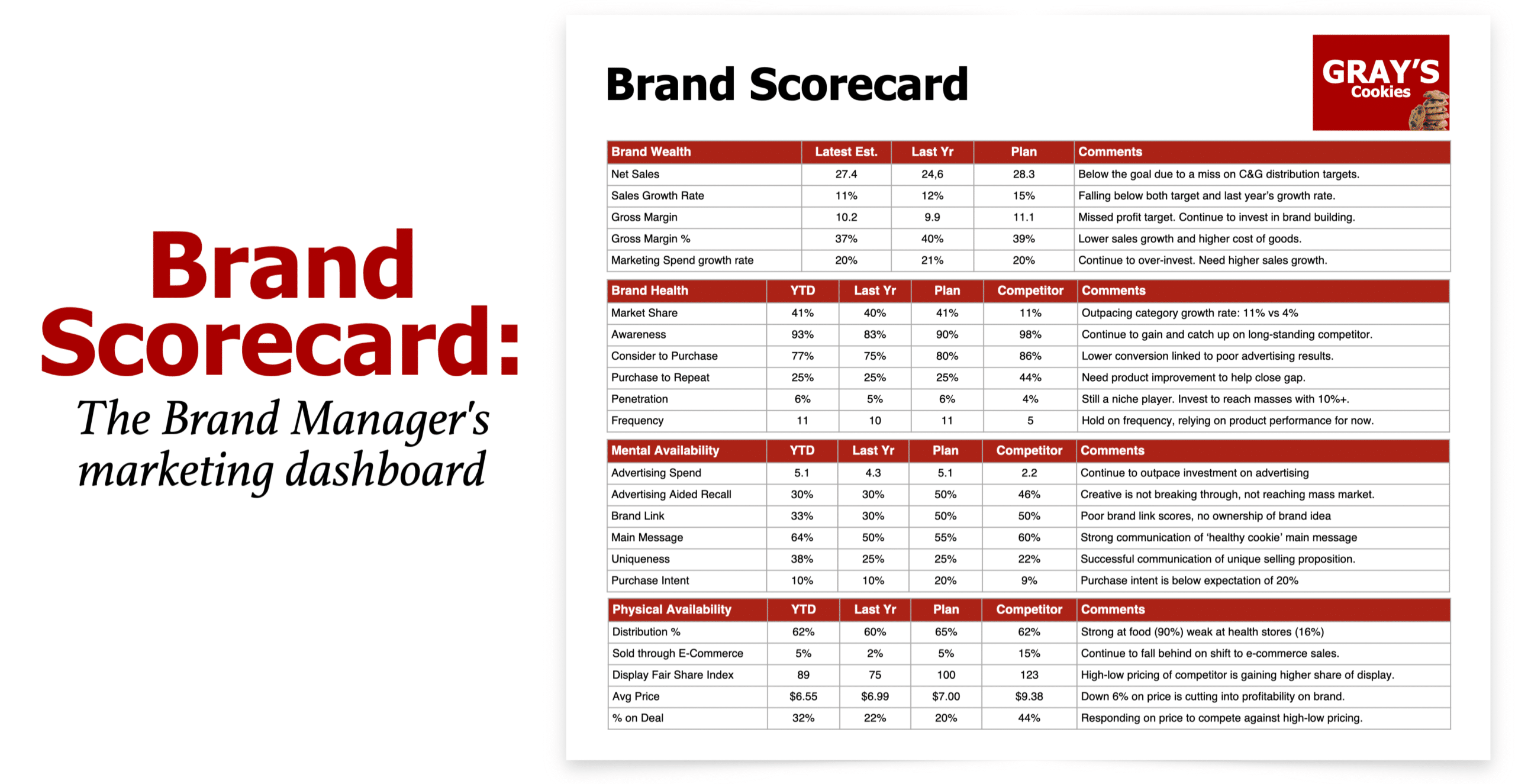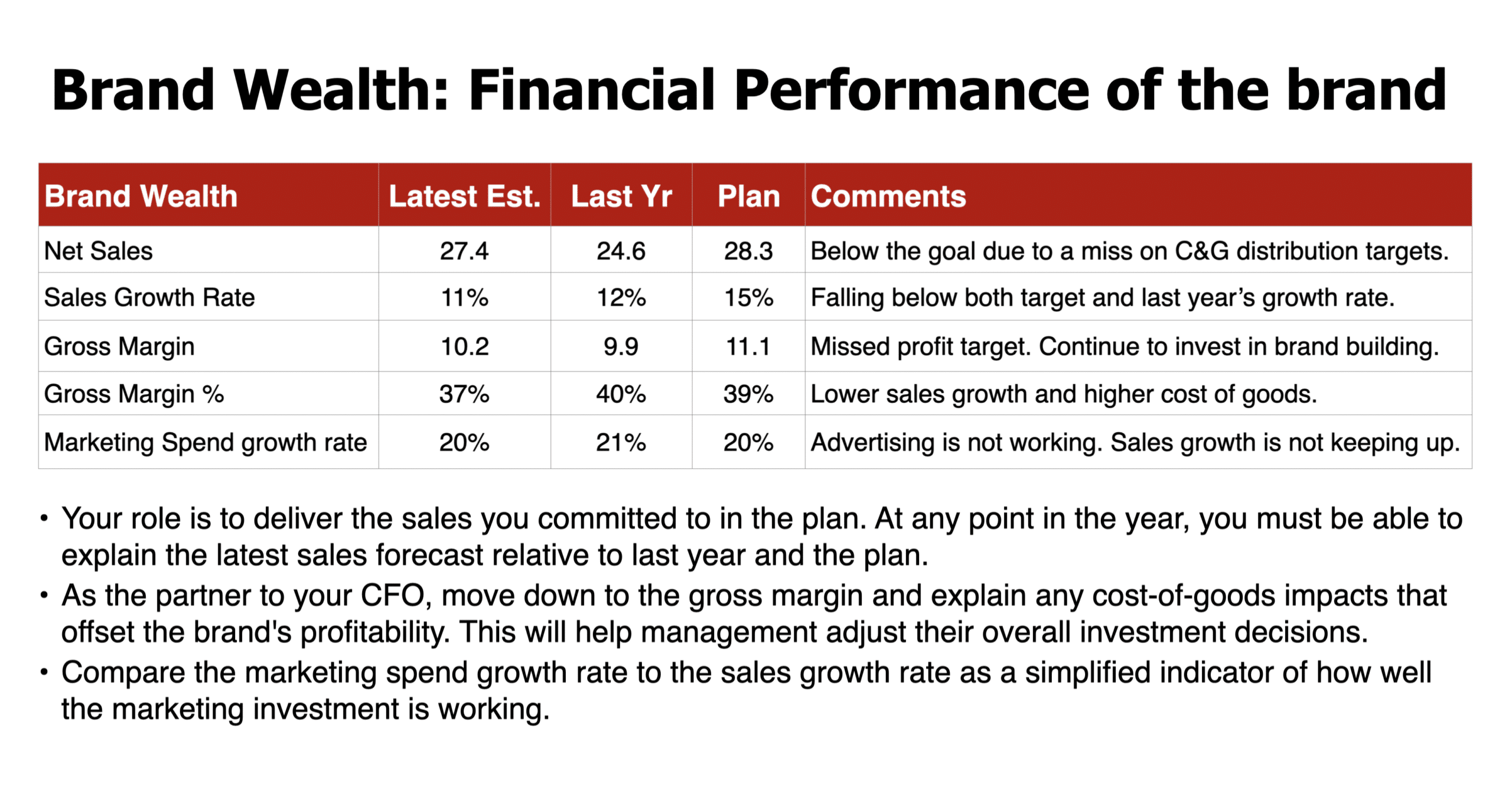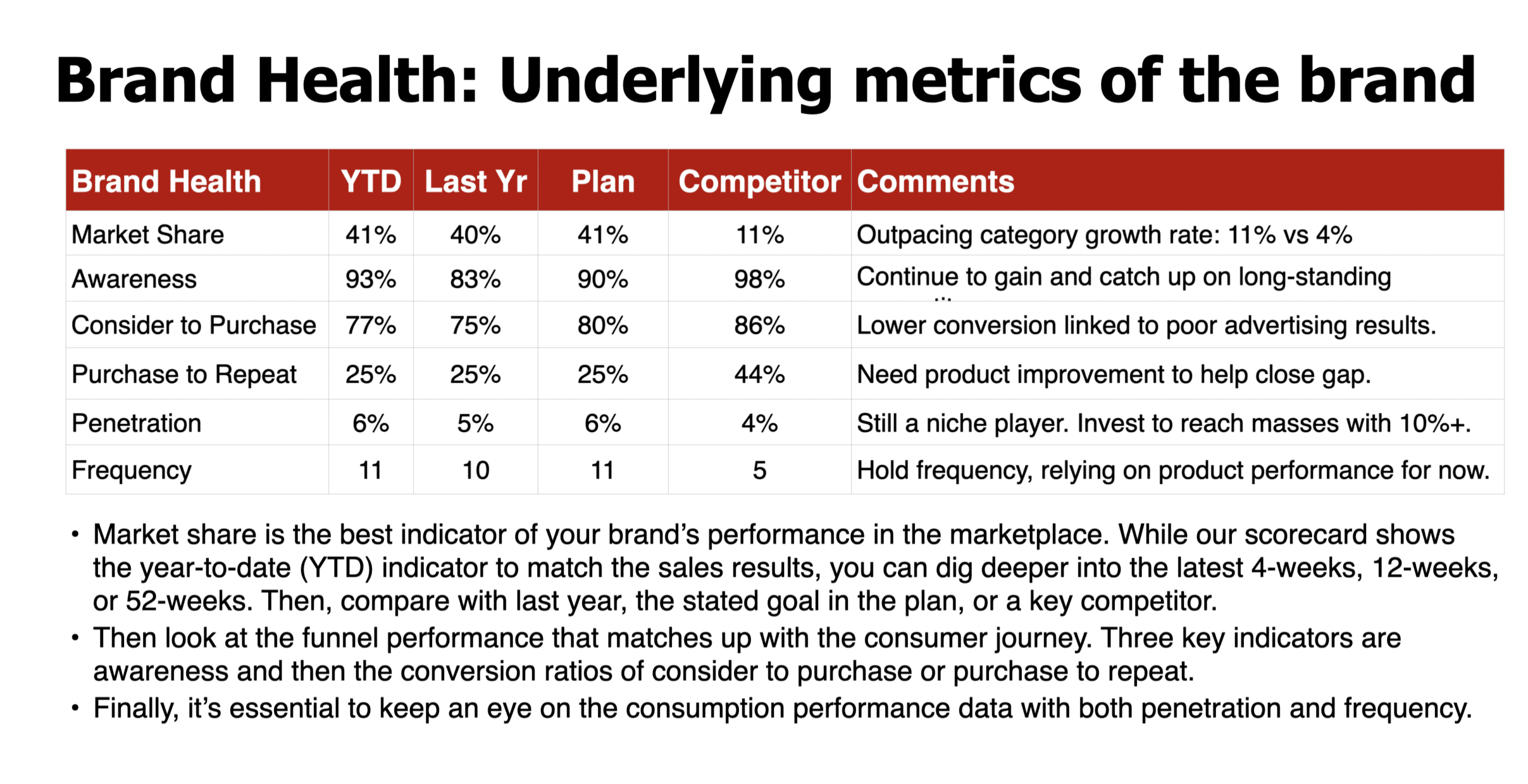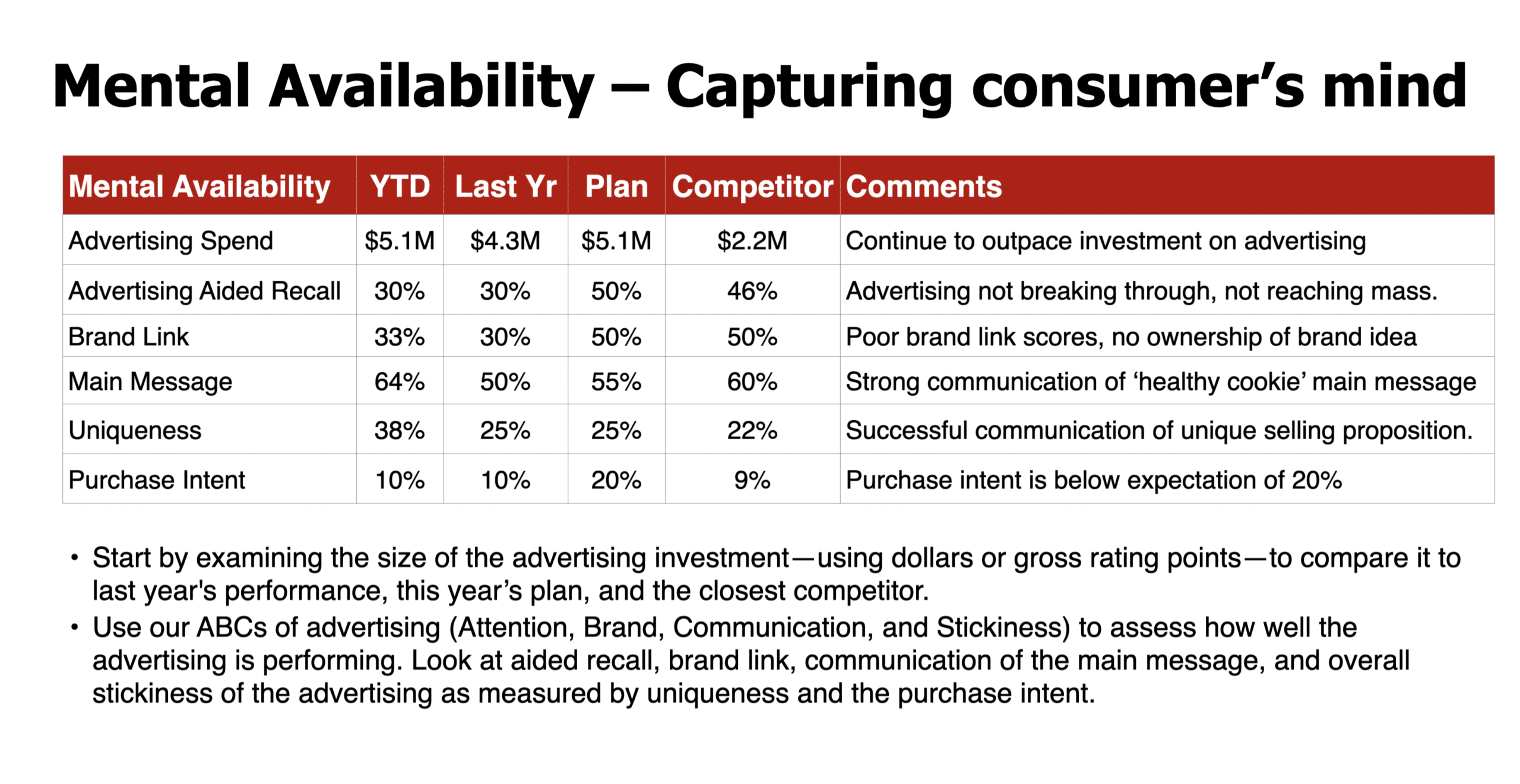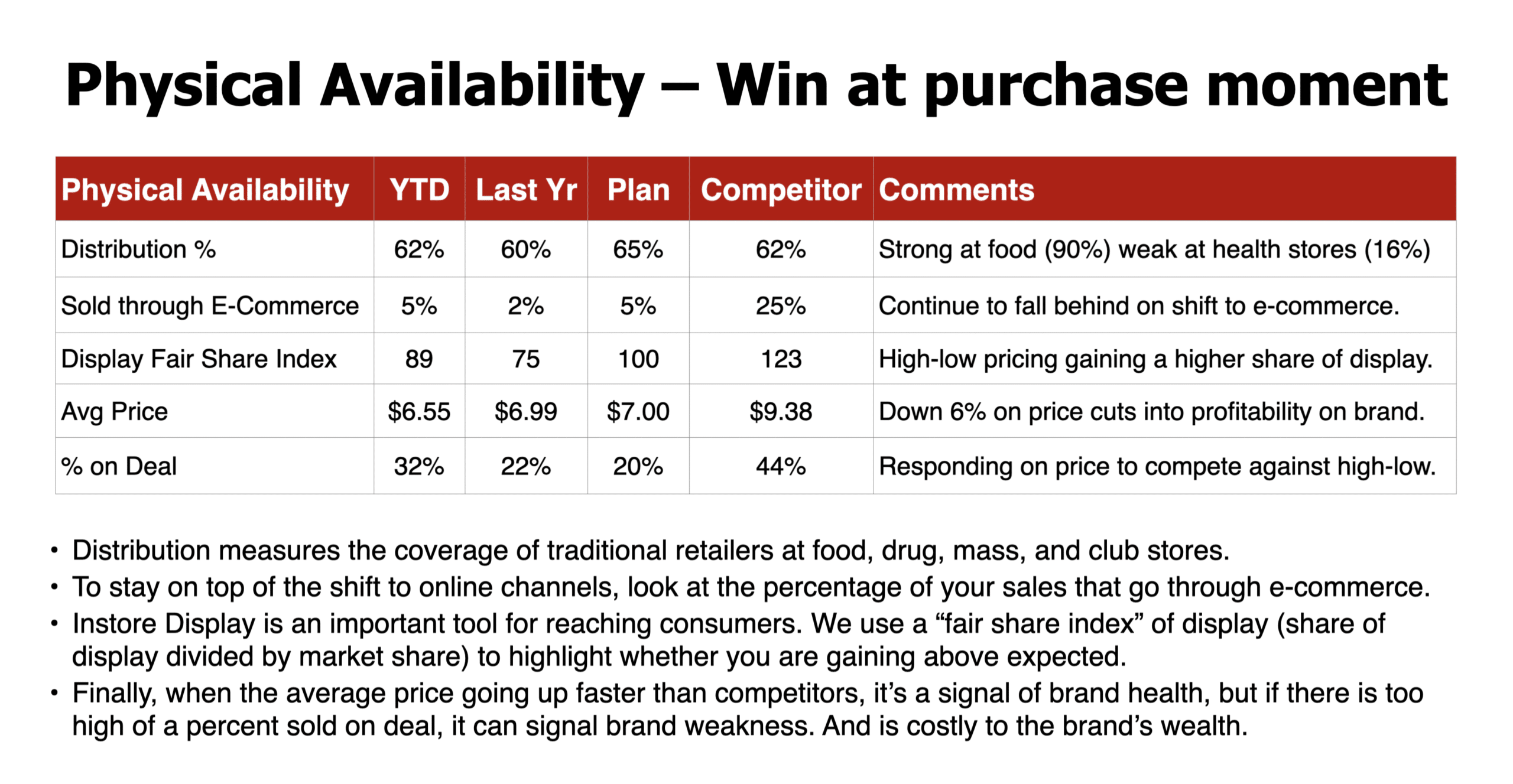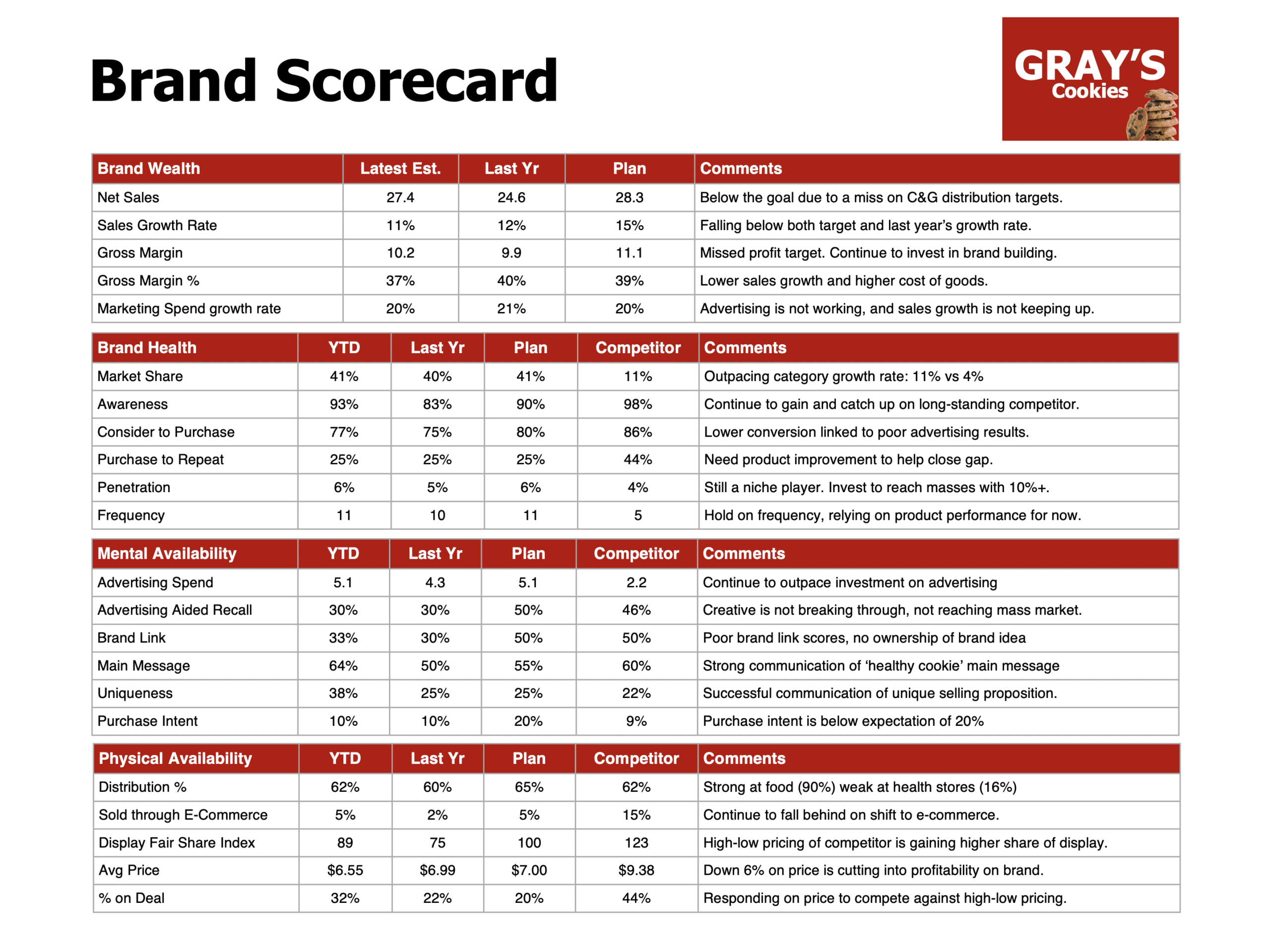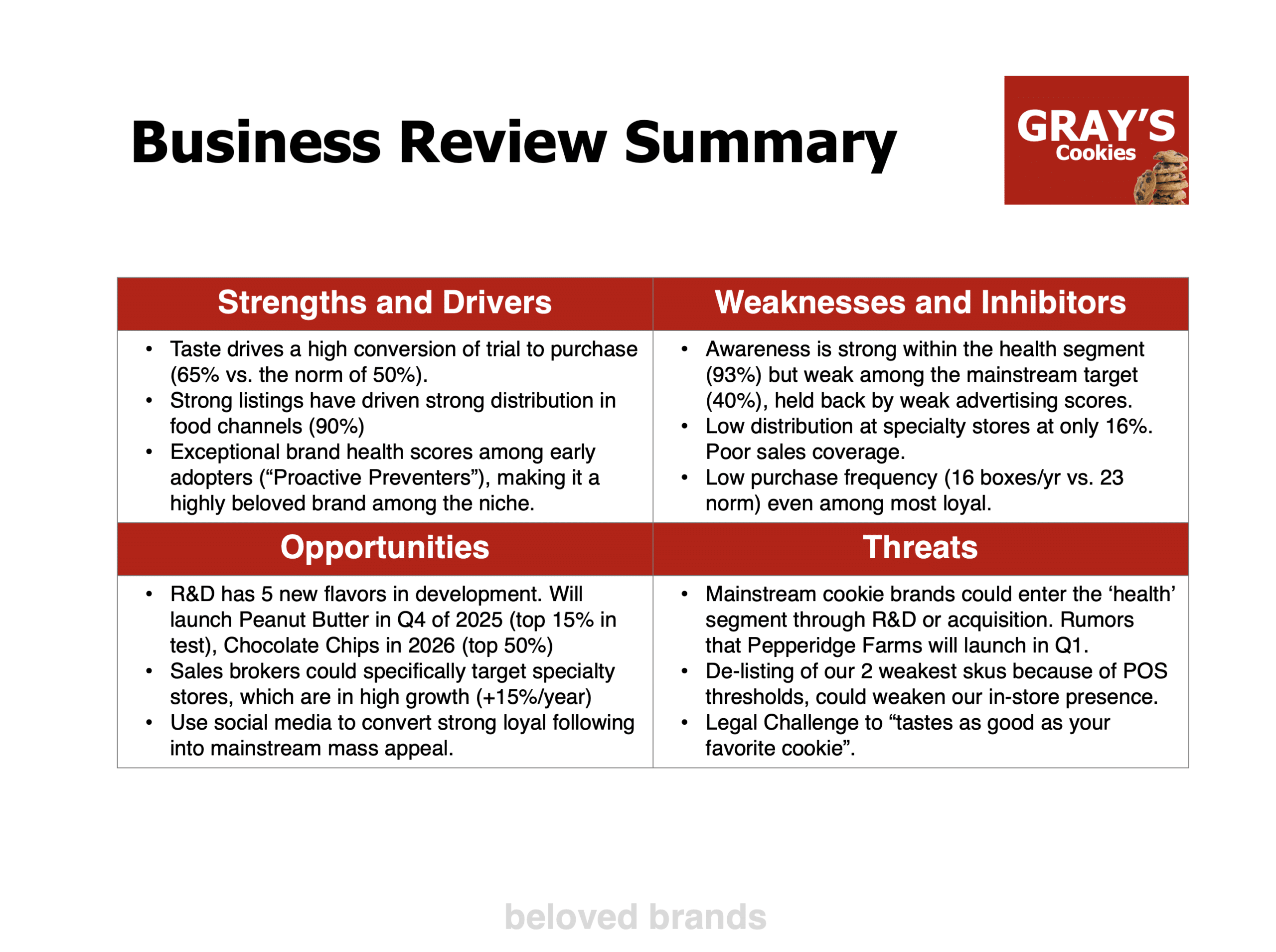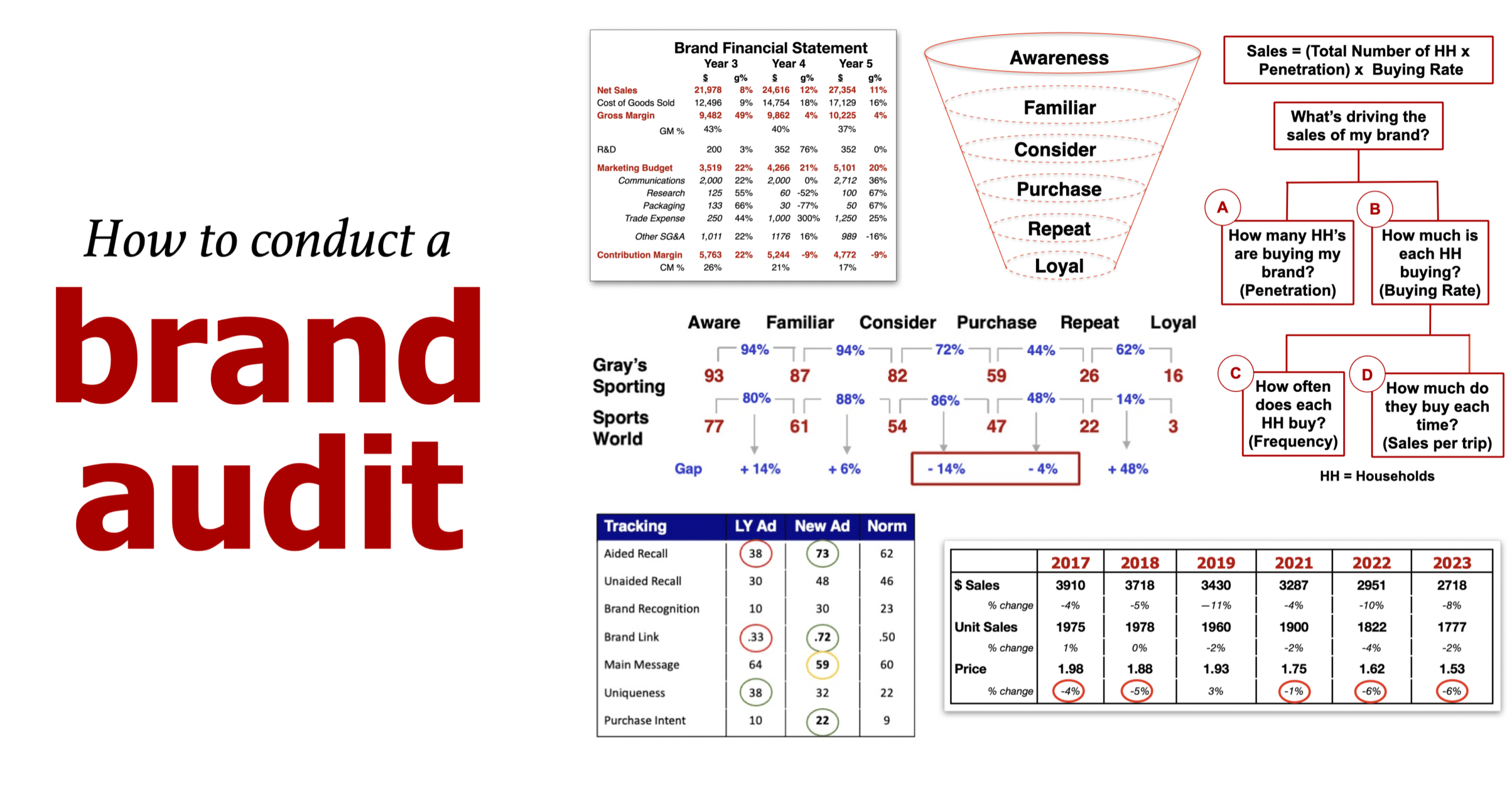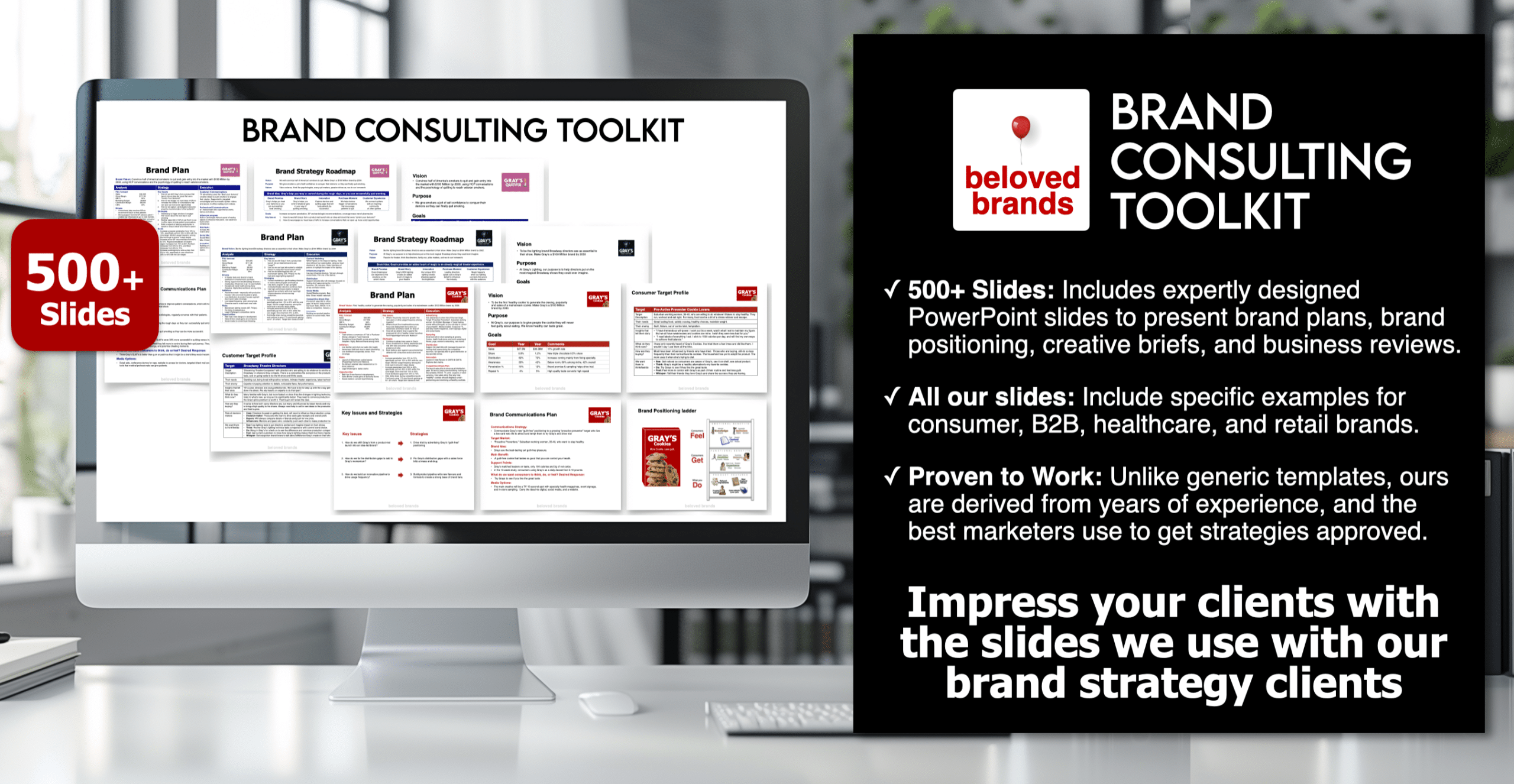As a seasoned brand leader, I have always believed that brand management means business management. With everything that we do, whether it is brand positioning, strategy, or marketing execution, you should see a number. That starts with the right marketing analytics. In brand management, getting lost in a sea of data and misinterpreting marketing signals is easy. That’s where our brand scorecard comes in handy—it organizes the data to highlight areas that require further digging. The brand scorecard acts as your beacon, highlighting where you are now and where to go next.
You can find our brand scorecard in our Consumer Brand Toolkit or the Consumer Business Review template.
Our brand scorecard looks at four key areas:
- Brand Wealth: Focus on the drivers of net sales, growth rates, profit, and marketing spending. You can track your progress throughout the year, and always be ready to compare your latest estimate to last year’s results and this year’s plan.
- Brand Health: As our marketing efforts must impact our consumers, the health scores are related to the funnel and consumption. You can use the nearest competitor as a gauge of performance.
- Mental Availability: The first lever is communication, which looks at attention (recall), brand link, and communication of the main message. We want to use the marketing execution to create uniqueness and persuasion.
- Physical Availability: We examine distribution factors, including levers related to e-commerce, display, and price.
To illustrate, click on the Brand Scorecard example above to see the details.
Brand Wealth – Your financial dashboard
Every Brand Manager should begin with a clear-eyed view of the brand’s financial health. Your role is to act like an owner of the brand’s profitability. The Brand Manager should monitor daily sales and provide a monthly report highlighting what is happening with both consumption and shipments to customers.
As a marketer, you should see the brand plan as an investment in the brand. Once approved, the plan becomes a promise to the organization and the shareholders. Use your scorecard as the starting point for deeper analysis. When you stay on top of the sales forecast any dip in sales or margins requires any explanation.
To illustrate, click on the Brand Scorecard example above to see the details.
In the context of brand wealth, a brand manager must ensure that sales align with the figures projected in the strategic plan. Throughout the fiscal year, the manager is accountable for providing an updated sales forecast that reflects variations from the previous year’s performance and the initial projections.
Collaborating closely with the CFO and delving into gross margin details is crucial. Here, the brand manager must articulate any fluctuations in the cost of goods and how such changes influence the brand’s profitability. This insight is invaluable for upper management, as it informs decisions regarding future investments.
The relationship between marketing spending and sales growth rates is a key metric to monitor. This ratio is a straightforward barometer of the marketing investment’s effectiveness, offering a glimpse into the efficiency of marketing expenditures in driving sales.
To go deeper into reading about brand profitability, Click to read.
Brand Health – Heartbeat of your brand
Just as a doctor examines a patient beyond the surface symptoms, brand health indicators like market share, awareness, and purchase intent require a nuanced understanding.
To illustrate, click on the Brand Scorecard example above to see the details.
In brand health analysis, market share emerges as a pivotal measure of your brand’s clout. Our scorecard provides a snapshot of the year-to-date performance, aligned with sales outcomes, yet a granular view is possible by dissecting trends across 4-week, 12-week, or annual intervals. This dissection benchmarks against previous years and planned objectives and sizes up against primary competitors.
Progressing further into the marketing funnel offers insights aligned with the consumer’s decision-making journey. Vital to this process are three core metrics: brand awareness and conversion ratios. One tracks the consumer’s journey from consideration to purchase, and another monitors the rate of repeat purchases.
Monitoring consumption performance data is equally crucial. This data highlights how many consumers are buying your product (penetration) and how often (frequency). These metrics provide a comprehensive picture of brand loyalty and recurring revenue potential.
To go deeper, read our marketing funnels article: Click to read more.
Mental Availability – Capturing the consumer's mind
Mental availability is about being top of mind at the point of purchase. It’s about creating brand salience. Look beyond the numbers. What do they say about your brand’s position in the consumer’s mind? Is your advertising spend translating into top-of-mind awareness, or is it just a drop in the ocean?
To illustrate, click on the Brand Scorecard example above to see the details.
Initiate the assessment of mental availability by scrutinizing the magnitude of the advertising spend, whether in dollar terms or via gross rating points. This should be juxtaposed with the prior year’s data, the current year’s targets, and the closest market rival to establish context and comparative benchmarks.
To evaluate advertising efficacy, employ our ‘ABCs of advertising’ methodology. This includes analyzing Attention to gauge initial consumer engagement, Brand linkage to ensure viewers associate the ad with your brand, Communication effectiveness regarding the central message, and Stickiness to measure the ad’s memorability and potential to influence Purchase Intent.
These dimensions are quantified through metrics such as aided recall, the accuracy of brand association, clarity in communicating the key message, and the distinctiveness and persuasiveness of the advertisement.
To go deeper, read our brand audit article: Click to read more.
Physical Availability – Standing out at the purchase moment
In the digital era, physical availability extends beyond shelf space to encompass the omnichannel presence. Your brand must be where the consumer looks, whether in a traditional brick-and-mortar retail store or an online marketplace. E-commerce figures on your scorecard are a reality check: Is your brand adapting to the changing retail landscape?
To illustrate, click on the Brand Scorecard example above to see the details.
In terms of physical availability, assessing distribution channels encompasses traditional retail outlets such as supermarkets, pharmacies, mass merchandisers, and warehouse clubs. With the evolving retail landscape, monitoring the portion of sales facilitated through e-commerce is critical to ensure the brand adapts to consumer buying behaviors online.
In-store displays serve as a vital mechanism for engaging consumers. Employing a “fair share index” for displays—calculating the ratio of your brand’s in-store display presence relative to its market share—can illuminate whether your brand is securing visibility commensurate with or exceeding market expectations.
Moreover, monitoring the average price movement relative to competitors offers insights into brand health. A price ascent outpacing that of rivals can signify a robust brand proposition. Conversely, a significant proportion of sales deriving from discounted pricing may indicate underlying brand challenges, potentially eroding brand equity and financial performance.
Brand Audit – The narrative behind the numbers
A brand scorecard is a narrative, a strategic story waiting to be told. It’s about interpreting the past, diagnosing the present, and predicting the future. Brand managers must craft this narrative by connecting the dots between what the scorecard reveals and the strategic steps that need to be taken.
To all brand leaders out there, our Brand Scorecard is your strategic ally. It’s a tool to guide you, not just a report to be read. It’s a foundation upon which to build your brand’s future.
To illustrate, click on the Brand Scorecard example above to see the details.
Piecing it together with a SWOT analysis
With all the insights gathered, it’s time to organize them cohesively. Our brand audit template ends with a SWOT analysis highlighting Strengths, Weaknesses, Opportunities, and Threats. Essentially, this helps you provide a concise yet comprehensive view of your brand’s current landscape. Below, you can find a brand audit example for Gray’s Cookies, presenting a clear picture and guiding the way forward.
Drivers/Strengths:
First, where is the brand excelling? This could be in areas of market share, consumer loyalty, or even profitability. To start, look at the factors of strength or inertia that accelerate your brand’s growth—a maximum of three bullet points. The driving factors could be related to brand assets, successful programs working, and favorable market trends. Look at new products, advertising, and channels. Essentially, keep fueling these growth drivers in your brand plan.
Inhibitors/Weaknesses:
Where are the gaps? These could be leaks in the consumer buying journey, underperforming marketing activities, or profitability issues. To start, look at the factors of weaknesses or friction that slow your brand down, a leak that needs fixing Achilles heel, competitive pressure, unfavorable market forces, channels, and specific segments. Importantly, how you write your brand strategy should work to minimize these weaknesses.
Opportunities:
Where can the brand grow further? These might be in untapped market segments, potential innovations, or improved marketing strategies. To start, look at the specific untapped areas in the market that would fuel future growth. It could be based on unfulfilled consumer needs, new technologies on the horizon, regulation changes, new distribution channels, or the removal of trade barriers. Essentially, find ways in your strategic plan to take advantage of these opportunities.
Threats:
What external factors might hinder growth? This could be rising competitors, changing market dynamics, or even shifting consumer behaviors. To start, look at the changing circumstances, including consumer needs, new technologies, competitive activity, distribution changes, or potential trade barriers that create potential risks to your growth. In your marketing plan, build strategies that will minimize the impact of these risks.
To illustrate, click on the Brand Scorecard example above to see the details.
Read up on how to conduct a brand audit
It’s imperative to understand that every business should conduct a brand audit annually. This process uncovers key issues and sets up a strategic plan for the brand’s future. Moreover, if you’re not integrating this essential step, you’re arguably neglecting the optimal management of your brand. Furthermore, adopting a monthly report system can keep your brand performance in check. For those unfamiliar with the process, this article aims to guide you on effectively conducting a brand audit. I will also show you our brand audit template with plenty of examples.


